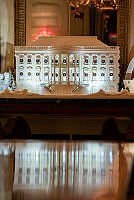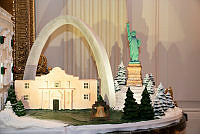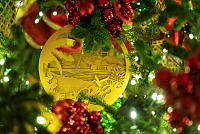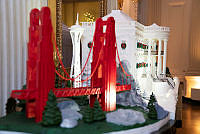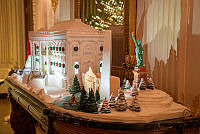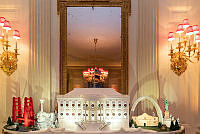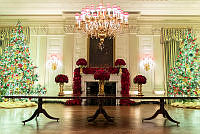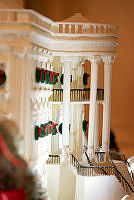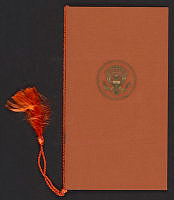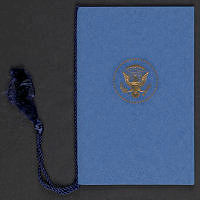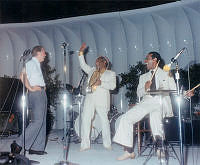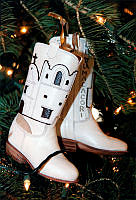Rubenstein Center Scholarship
Things That Go Bump in the Blue Room
Why is the White House Haunted?
Most White House ghost stories revolve around long-deceased presidents or first ladies, such as Abigail Adams, Thomas Jefferson, Dolley Madison, Andrew Jackson, and Abraham Lincoln. Some are more tangential to the White House, such as Anna Surratt, the daughter of Lincoln assassination conspirator Mary Surratt. But legends featuring spooks and specters aren’t restricted to nineteenth-century stories that have been repeated and recounted over the years. More recent occupants of the White House have also added to the oral tradition of ghostly tales at 1600 Pennsylvania Avenue.
President Ronald Reagan publicly recounted his ghostly experiences at the White House at a 1986 State Dinner honoring then Canadian Prime Minister Brian Mulroney.1 According to the President, the Reagans’ dog, Rex, “barked frantically” at the entrance of the Lincoln Bedroom and subsequently refused to enter. President Reagan began to seriously consider the presence of a spirit inside the Lincoln Bedroom when his daughter and son-in-law reported seeing an apparition there on more than one occasion.2

President Ronald Reagan’s dog Rex may have sensed Lincoln’s ghost inside the White House.
Ronald Reagan Presidential Library and Museum/National Archives and Records AdministrationIf you doubt the veracity of President Reagan’s story, here’s another contemporary affirmation of the presence of ghosts inside the White House. First Daughter Jenna Bush Hager, in a 2018 interview on the “Today” show with Hoda Kotb, confessed that she and her twin sister Barbara encountered something supernatural at the White House.3 While living in the White House Residence as a teenager, Hager recalled that she and Barbara woke up in the middle of the night to the sound of her phone ringing. They both heard 1920s piano music “clear as day coming out of the fireplace” that was located inside their bedroom.
There were no reports of President Bill Clinton or First Lady Hillary Clinton seeing a ghost, but on a morning talk show, Mrs. Clinton described the White House as “a little creepy,” especially at night.4 However, at least one ghost did make an alleged appearance during the Clinton administration. President Clinton’s brother Roger claimed to feel Lincoln’s presence in the White House.5
Finally, First Lady Michelle Obama confessed that she and President Obama experienced some unexplained occurrences during their eight years living in the White House.6 She reported hearing strange sounds in the hallway of the residence in the middle of the night, so disturbing that both she and the president were compelled to investigate. Even creepier, she said that some members of her family felt at times that something was inexplicably chewing or gnawing at their feet.

First Lady Michelle Obama confessed that she and President Barack Obama sensed the presence of a potential ghost one night inside the White House Residence
Pete Souza, Official White House PhotoWhy do White House ghost stories continue to proliferate, even recently? There is a salience and persistence to these spooky stories and perhaps even a compulsion to add to the spectral mythology surrounding the nation’s most famous residence. Ghost stories aren’t simply tales to entertain children. More often than not, they communicate culturally significant information.7 History is infused with ghost stories, with old buildings and residences playing a major role. In fact, “historical ghosts” are one of eight archetypical categories of ghost stories identified by Roger Clarke in Ghosts: A Natural History.8 Historical ghosts are often repetitive, performing the same action over and over again. Their appearances are typically tied to a particular date, such as when they died or the anniversary of a traumatic event.9
In American ghost stories, apparitions often impart important lessons to the living. They right wrongs or signal a lasting unease about earlier tragedies, injustice, or unfinished business.10 This may explain why Abraham Lincoln is the most often sighted ghost inside the White House. His assassination interrupted the work of Reconstruction that Lincoln had only referenced weeks earlier in his Second Inaugural Address. Because of his murder, Lincoln was unable to lead the second act of the Civil War. The American fascination with how history might have been different if Lincoln lived explains why occupants of the White House continue to “see” his image or “feel” his presence. Ghost stories allow us to play out the fantasy that “dead people are not really dead,” thus enabling the anchoring of a chaotic past with the present.11
Likewise, it explains the stories concerning the haunting of Anna Surratt. According to lore, the daughter of Mary Surratt can be heard frantically knocking on the front door of the White House, pleading for President Andrew Johnson to spare her mother’s life before she was executed for conspiring to kill Lincoln. After her mother’s conviction, Anna Surratt did petition for her mother’s life. She traveled to the White House to meet with President Johnson but was denied entrance. To no avail, a fellow condemned conspirator attested to her innocence before the execution. Mary Surratt’s involvement in the Lincoln assassination was never definitively resolved.12 The lack of clarity about Mary Surratt’s role in the assassination undoubtedly led to the prevalence of this ghostly tale featuring her daughter’s continued and unresolved suffering.

Anna Surratt, the daughter of Lincoln assassination conspirator Mary Surratt, allegedly haunts the White House.
National Archives and Records AdministrationGhost stories are often centered around locations of great drama, uncertainty, strife, or death. For example, the Civil War’s Gettysburg battlefield is allegedly filled with ghostly apparitions of soldiers who lost their lives there. Graveyards are another popular location. With Georgetown’s Oak Hill Cemetery as the setting, George Saunders’ recent bestseller Lincoln in the Bardo creatively explores President Lincoln’s consuming grief after his son Willie died. Dark, dimly lit forests are likewise spooky, serving as the setting for perhaps the most famous American ghost story, Washington Irving’s The Legend of Sleepy Hollow.
However, the most common setting for ghost stories is houses. In particular, Americans have an intimate connection to the places where they live, making ghost stories situated in homes prevalent within our literary and oral tradition of storytelling.13 Houses are often active participants in the detailed plot of a ghost story. Thus, it is not surprise that the White House, which serves as the home for the president and first family, would serve as an ideal setting for a wide variety of scary American folklore.
Like any historic home, the White House certainly bore witness to a number of deaths over the years, including President William Henry Harrison, President Zachary Taylor, and First Lady Ellen Wilson.14 Interestingly enough, the most prominent White House ghost stories do not center around the individuals who expired within the walls of the White House.

The White House is the ideal setting for a classic American ghost story.
Library of CongressInstead, it is more likely that the White House has generated a considerable number of ghost stories throughout American history because as both a residence and office of the president, the setting has born considerable witness to rivalry, conflict, familial discord, and despair. For example, the ghost of Andrew Jackson, who continued to hold great antipathy for his political enemies many years after his electoral defeat in 1824, was reportedly seen and felt by First Lady Mary Todd Lincoln and President Harry Truman. Jackson’s ghost was in a state of great agitation, a reflection of his adversarial nature and long-lasting political grudges.
In conclusion, as ghost stories attempt to resolve or vanquish the tragedy of earlier lives, the White House provides excellent fodder as a setting for fantastic, scary tales. In a larger context, ghost stories are creative attempts to make sense of history’s relentless supply of strife, unresolved insecurities, and human struggle. Continued curiosity about the White House and the tumultuous history of its inhabitants create a perfect dramatic combination for the quintessential American ghost story.














